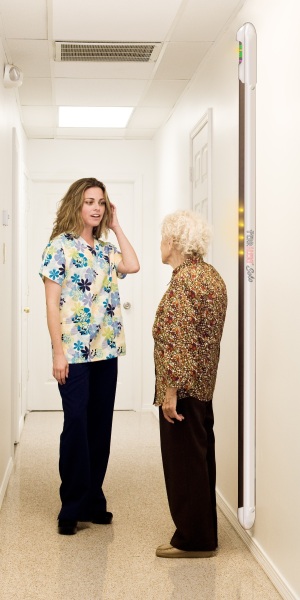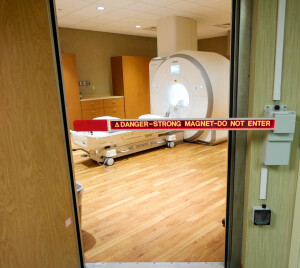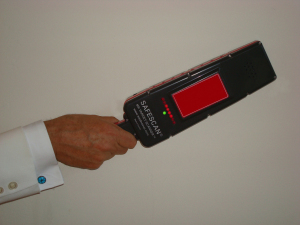
Many providers use wall mounted ferromagnetic detectors, like the Ferroguard Assure, planted in Zone 3, right outside the magnet room. Photo courtesy: Metrasens
Safety first in the MR environment
October 28, 2019
by John R. Fischer, Senior Reporter
A quarter of MR safety events result from the presence of unintended internal and external ferromagnetic objects brought into the scanning room. That was the consensus arrived at by researchers from the Pennsylvania Patient Safety Authority, who identified more than 1,100 such events submitted to its reporting system between 2009 and 2017.
At its core, an MR system is an extremely powerful magnet, so objects entering the room can cause serious problems. In many cases, that can include patient implants, such as defibrillators and pacemakers.
“Out of the three million Patient Safety Organization (PSO) reports we took in, we found 2,000 related to MR just in basic research,” Jason Launders, director of operations health devices at ECRI. “Of those, about 1,000 appeared to be MR safety incidents. The number of times the report said the patient specified having no implants, only for such a device to be found when they entered the room, or underwent further screening with a detector was concerning.”
The frequency at which these events take place calls for technologies that not only prevent these incidents but enhance awareness about the potential for them. One common solution is ferromagnetic (FM) detectors, which can detect and alert providers to the presence of ferromagnetic materials on a patient, or in their possession. But detectors are not an all-in-one solution; they require enforced protocols for instilling a culture of safety within the MR suite.
Smarter tool, stricter protocols
Many experts encourage MR providers to adopt at least two detectors at different locations to double-check patients, as well as unsuspecting staff members who may try to enter the scanning area with magnetic objects.
“Our Ferroguard Screener is used as the final step in the patient screening process and should be located in Zone 2, close to the patient changing area,” said Colin Robertson, senior vice president of detector manufacturing company, Metrasens. “Our Ferroguard Assure detector is wall-mounted, usually immediately outside the magnet room door, in Zone 3.”
The presence of these detectors, both for the entryway and pre-screening process, can help reduce the number of adverse events that take place while also teaching providers how to improve their screening processes. Kopp Development's FerrAlert offers spatial recognition technology for identifying the location of ferromagnetic objects on the body, alerting providers to be aware of common areas to check during pre-screening where people may carry these objects.
Other important features include logging systems for recording all ferromagnetic objects that enter a magnet room, as required by the Joint Commission, and automated data capture, metrics and reporting.
Smarter tools, stricter protocols“The question that comes up quite often is, ‘Why do these things keep happening?,’” said Keith Kopp, president of Kopp Development, which offers the FerrAlert line of detectors, and Anna Srb, the company’s director of marketing and sales. “What we’ve tried to develop is a product line that in essence allows you to see what led up to an incident and what people did about it, as well as to improve policies and procedures to help cut down on these events.”
The most important component to MR safety is the presence of a dedicated, intelligent MR technologist who cares about the safety of the patient and will do everything possible to prevent accidents from occurring, according to R. Kemp Massengill, president and quality assurance director for Mednovus, which offers the handheld SAFESCAN ferromagnetic detector.
Part of that means the technologist will be careful to avoid having ferrous material on them and activating pass-through detector alarms. “These alarms, which are not really 'false', as ferromagnetic material on the MR technologist is being detected, can easily be eliminated by being 'ferromagnetically clean',” said Massengill. “This simple change makes pass-through systems light-years more effective, as alarm fatigue is no longer an annoying problem.”
Limitations and policies
One important consideration when implementing ferromagnetic detectors in the MR suite is that the detectors alone will not resolve issues. They need to be incorporated into safety protocols that staff members are trained to follow.
“Some people might get a little lax in their procedures and policies. An FM detector, however, is meant to provide another level of security,” said Joel Kellogg, director of engineering for Field Management Services, a provider of electromagnetic field consulting and services. “You have to realize that if you are going to implement ferromagnetic detection systems, they have to become integral to those procedures.”
ECRI’s Launders stressed that providers should train staff not just in how to use detectors but to understand their capabilities and limitations, and how their own actions can help enhance the safety provided by the detector. That means periodically testing devices to ensure they are working correctly; and having patients change out of street clothes and into gowns before heading toward the magnet room.
They should also carefully question a patient’s answers to prescreening process questions, he added. For instance, if a patient is asked if they have an implant of any kind and they respond that they are not sure or know they have but can’t identify where, staff members should not let them enter the MR room until they have a definite answer.
Another important factor to consider is the number of alarms a detector carries, according to Tobias Gilk, founder of Gilk Radiology Consultants and a safety consultant for Metrasens. Having too many can contribute to a state of fatigue and immunity to the onset of alarms among staff members.
“To the degree that we can reduce these spurious alarms and make it so the detector goes off as infrequently as possible increases the psychological impact of when the alarm does go off,” he said. “It becomes a more meaningful event in which we can double check the person or people for whom the alarm went off.”
Joe Barwick and Steve Blacker, founders of MR safety company Aegys, said that ferromagnetic detectors should be viewed as information gathering tools that assist in decision-making for screening. “They have been designed to alarm on anomalies detected in proximity to the detectors that require conscientious review and follow-up. Additionally, they should be utilized or placed in areas that allow for proper reaction in advance of the entrance to the MR room.”
Choosing a detector for an MR environment requires an understanding of its capabilities and limits, and for the provider to communicate their expectations with the vendor.
“If a facility says, ‘We don’t want the detector to alarm on underwires,’ you have to recognize you probably also mean you don’t want it to alarm on cell phones, laryngoscope blades and possibly stethoscopes,” said Gilk. “They’ve created an expectation for themselves that today simply can’t be met by the technology. Something is going to give, so it’s important to be clear with ferromagnetic detection vendors what your expectations are.”
Looking ahead
Safety, overall, is improving in the MR environment, with new regulations requiring appropriate labeling for devices like implants, performing reviews of items consistently within the proximity of the room and requiring staff and technologists to undergo certification programs. Encouraging patients to be honest about their medical history, particularly regarding implants is vital to MR safety. Having to search through medical records for verification is not always possible and it delays exams, wastes time and adds to staff workloads.
As detector technology becomes increasingly sophisticated it is also being supported by new safety protocols enacted by safety organizations. The ACR Committee on MR Safety, for instance, just enacted a new 2019 recommendation for room caution barriers to be implemented to prevent inadvertent access to the MR room, while the door to it is open.
Kopp and Srb with Kopp Development welcome the enactment of these regulations but believe it is only one part of the equation. The other is the enforcement of them. “One of the things that we would like to see is not only policies and procedures implemented but ones that are enforced. Nobody would let technologists into the OR without certain steps he or she would have to take. In the magnet room, the technologist is in charge and needs to enforce policies and procedures for staff from other departments and patients, as well as for their own staff and themselves.”
At its core, an MR system is an extremely powerful magnet, so objects entering the room can cause serious problems. In many cases, that can include patient implants, such as defibrillators and pacemakers.
“Out of the three million Patient Safety Organization (PSO) reports we took in, we found 2,000 related to MR just in basic research,” Jason Launders, director of operations health devices at ECRI. “Of those, about 1,000 appeared to be MR safety incidents. The number of times the report said the patient specified having no implants, only for such a device to be found when they entered the room, or underwent further screening with a detector was concerning.”
The frequency at which these events take place calls for technologies that not only prevent these incidents but enhance awareness about the potential for them. One common solution is ferromagnetic (FM) detectors, which can detect and alert providers to the presence of ferromagnetic materials on a patient, or in their possession. But detectors are not an all-in-one solution; they require enforced protocols for instilling a culture of safety within the MR suite.
Smarter tool, stricter protocols
Many experts encourage MR providers to adopt at least two detectors at different locations to double-check patients, as well as unsuspecting staff members who may try to enter the scanning area with magnetic objects.
“Our Ferroguard Screener is used as the final step in the patient screening process and should be located in Zone 2, close to the patient changing area,” said Colin Robertson, senior vice president of detector manufacturing company, Metrasens. “Our Ferroguard Assure detector is wall-mounted, usually immediately outside the magnet room door, in Zone 3.”
The presence of these detectors, both for the entryway and pre-screening process, can help reduce the number of adverse events that take place while also teaching providers how to improve their screening processes. Kopp Development's FerrAlert offers spatial recognition technology for identifying the location of ferromagnetic objects on the body, alerting providers to be aware of common areas to check during pre-screening where people may carry these objects.
Other important features include logging systems for recording all ferromagnetic objects that enter a magnet room, as required by the Joint Commission, and automated data capture, metrics and reporting.
Vendors encourage providers to use at least two ferromagnetic detectors, one like the FerrAlert Solo during pre-screening, and another right outside the magnet room. Photo courtesy: Kopp Development
The most important component to MR safety is the presence of a dedicated, intelligent MR technologist who cares about the safety of the patient and will do everything possible to prevent accidents from occurring, according to R. Kemp Massengill, president and quality assurance director for Mednovus, which offers the handheld SAFESCAN ferromagnetic detector.
Part of that means the technologist will be careful to avoid having ferrous material on them and activating pass-through detector alarms. “These alarms, which are not really 'false', as ferromagnetic material on the MR technologist is being detected, can easily be eliminated by being 'ferromagnetically clean',” said Massengill. “This simple change makes pass-through systems light-years more effective, as alarm fatigue is no longer an annoying problem.”
Limitations and policies
One important consideration when implementing ferromagnetic detectors in the MR suite is that the detectors alone will not resolve issues. They need to be incorporated into safety protocols that staff members are trained to follow.
“Some people might get a little lax in their procedures and policies. An FM detector, however, is meant to provide another level of security,” said Joel Kellogg, director of engineering for Field Management Services, a provider of electromagnetic field consulting and services. “You have to realize that if you are going to implement ferromagnetic detection systems, they have to become integral to those procedures.”
ECRI’s Launders stressed that providers should train staff not just in how to use detectors but to understand their capabilities and limitations, and how their own actions can help enhance the safety provided by the detector. That means periodically testing devices to ensure they are working correctly; and having patients change out of street clothes and into gowns before heading toward the magnet room.
They should also carefully question a patient’s answers to prescreening process questions, he added. For instance, if a patient is asked if they have an implant of any kind and they respond that they are not sure or know they have but can’t identify where, staff members should not let them enter the MR room until they have a definite answer.
Another important factor to consider is the number of alarms a detector carries, according to Tobias Gilk, founder of Gilk Radiology Consultants and a safety consultant for Metrasens. Having too many can contribute to a state of fatigue and immunity to the onset of alarms among staff members.
Automated barriers like the Aegys TechGate prevent inadvertent access to the MR room while the door is open. Photo courtesy: Aegys
Joe Barwick and Steve Blacker, founders of MR safety company Aegys, said that ferromagnetic detectors should be viewed as information gathering tools that assist in decision-making for screening. “They have been designed to alarm on anomalies detected in proximity to the detectors that require conscientious review and follow-up. Additionally, they should be utilized or placed in areas that allow for proper reaction in advance of the entrance to the MR room.”
Choosing a detector for an MR environment requires an understanding of its capabilities and limits, and for the provider to communicate their expectations with the vendor.
“If a facility says, ‘We don’t want the detector to alarm on underwires,’ you have to recognize you probably also mean you don’t want it to alarm on cell phones, laryngoscope blades and possibly stethoscopes,” said Gilk. “They’ve created an expectation for themselves that today simply can’t be met by the technology. Something is going to give, so it’s important to be clear with ferromagnetic detection vendors what your expectations are.”
Looking ahead
Safety, overall, is improving in the MR environment, with new regulations requiring appropriate labeling for devices like implants, performing reviews of items consistently within the proximity of the room and requiring staff and technologists to undergo certification programs. Encouraging patients to be honest about their medical history, particularly regarding implants is vital to MR safety. Having to search through medical records for verification is not always possible and it delays exams, wastes time and adds to staff workloads.
The SAFESCAN target scanner is a unique, handheld solution to ferromagnetic detection. Photo courtesy: Mednovus
Kopp and Srb with Kopp Development welcome the enactment of these regulations but believe it is only one part of the equation. The other is the enforcement of them. “One of the things that we would like to see is not only policies and procedures implemented but ones that are enforced. Nobody would let technologists into the OR without certain steps he or she would have to take. In the magnet room, the technologist is in charge and needs to enforce policies and procedures for staff from other departments and patients, as well as for their own staff and themselves.”


